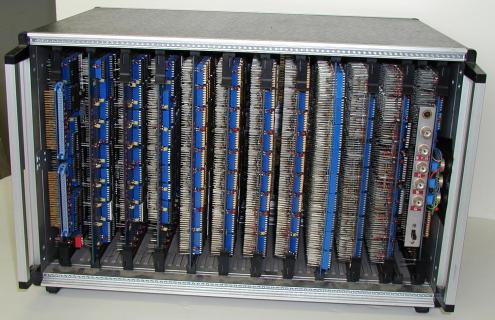The Computer Laboratory Relics Database
The database contains details of over 200 artifacts ranging from turn of the century calculating machines, through pieces of our early electronic machines (EDSAC I and II), to bits and pieces built for specific research projects, or extracted from interesting commercial machines.
There are also still significant holes in the database, being filled as time permits. All information and photographs produced by this Search facility are subject to the departmental Relics Project copyright and license terms.
Unique id/year of acquisition: CL-107/99
Name: Rainbow logic


Other No marked on object: none
Inscription: none
Dimensions: 440x330x290
Description: Black metal case open at front and rear, carrying handles at front, plastic feet on bottom. rear shows lots of wire-wrapped cross wiring. Inside is 12 cards, all different. Most are labelled, most have edge handles. the card at the right side has 5 coax connectors, a switch and an LED. The card at the left has two 50-way ribbon connectors.
Class: computer
Machine name: Rainbow
Condition: good
Notes: The Rainbow display was an experimental terminal to support graphical interaction with the Cambridge Distributed System. It is built around one of the Motorola 68000 computers that were also used in the main processor bank. This has two peripheral controllers based on 6809 processors, one a standard ``Type 2'' system controlling the ring interface and the other handling the keyboard, mouse and tablet. The second crate contains the display hardware itself. This consists of a bit-slice micro-controller built around AMD 2901 chips, 64k 16-bit words of video memory and an output pipeline that assembled a video signal in real time for windows stored in different parts of the memory. (BCS Technical Award 1985 to N.E. Wiseman.)
See also: CL-104/99
See also: CL-106/99
See also: CL-106/99
Notes
- Identifiers are written on objects in the format CL-uuu/yy/gg (u = unique identifier, y = year of acquisition or entry into database, g = group id. The group id is only used if there are more than one of a given object.) eg 80/99/3. This format was adopted to make the identifiers from this exercise distinct from any used in previous cataloguing attempts.
- Photographs. Where relevant the database contains a comma-separated list of Unix path names of pictures of the object, in jpeg format. If photos are available a thumbnail image will be shown as a search result. Click on this to see the full size image.
- Date format: dd.mm.yy
- Name format: Full first name (where known), else initial and surname
- Dimensions: max x next x min (all in mm)
- Lists in all fields are comma separated.
- n/a = not applicable
blank = no information entered
? = information uncertain or unknown
The database search allowed by this page is selective and will only display information that is present, i.e. it will not display labels for empty fields. - Not all information in the database is displayed on the web page produced by this search facility, some of it is private (eg location of object, for security reasons).
- The Notes section of the database may contain html formatting commands to allow it to be displayed to best advantage on the web pages output by this search facility.